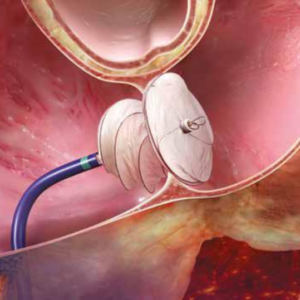- +91 83103 67685
- info@drameetoswal.com
- Basavanagudi
A synthetic device is placed between the walls of the heart, to avoid harmful leakage in the heart.

Device Closure is used to close a leak or opening between the right and left sides of the heart. A heart has four chambers. The upper two chambers are called Atria. The lower chambers are known as Ventricles. The right side has impure (deoxygenated) blood and the left side is responsible for the supply of oxygenated blood to the body. There can arise a situation when there is a hole between these two sides. These conditions are called as congenital heart disease.
The most common conditions for which device closure therapy is done are:
Oxygen-rich blood leaks from the left atrium to the right atrium.
Leakage of the oxygen-rich blood from the left ventricle to the right ventricle
A hole between the pulmonary artery and aorta of the heart. (Found in newborns)
Hole between the left and right atria of the heart.

A hole in the heart can allow blood to leak into the wrong chambers of your heart. This can strain your heart and lungs to work harder, causing symptoms and complications, including:
If you are facing any such symptoms, you may be suggested to undergo Device Closure surgery by your cardiologist
The walls of the heart are distinguished maintaining a good circulation system. But in some defect situations, there can be holes in the heart, either in the atrial wall or the ventricle wall, this can result in the leaking of blood resulting in performance failure of the heart. These holes can be filled up non surgically or surgically, with some devices (synthetic parts). This is done in order to maintain the heart’s performance.
Device closure surgery is performed by a heart surgeon or an interventional cardiologist, both specialise in heart procedures.
Yes, device closure is a minimally-invasive procedure. It can be done with cardiac catheterization using a catheter threaded from the groin vein up to your heart. It may also be done as open-heart surgery but only in serious cases.
It is a relatively small procedure taking close to 2 hours of operational time. The recovery can depend from patient to patient. For catheter guided device therapy, patients are sent home next day.
ASD is a typical device closure that fills up the gap in atrial septum and VSD uses a similar method to close a hole in ventricular septum.
When the baby is born, the pulmonary and aorta are joined with ductus arteriosus. This duct gets closed within a few days which is normal. A defect occurs when the opening doesn’t close. The aorta & pulmonary artery still have an open connection between them.
Device closure reduces the symptoms and complications related to a hole in your heart. This can aid your heart and lungs, helping you live a long and productive life. It can greatly reduce the possibility of stroke, heart failure, and arrhythmia in the future.
Subscribe our newsletter for latest information in the field of cardiology
WhatsApp us